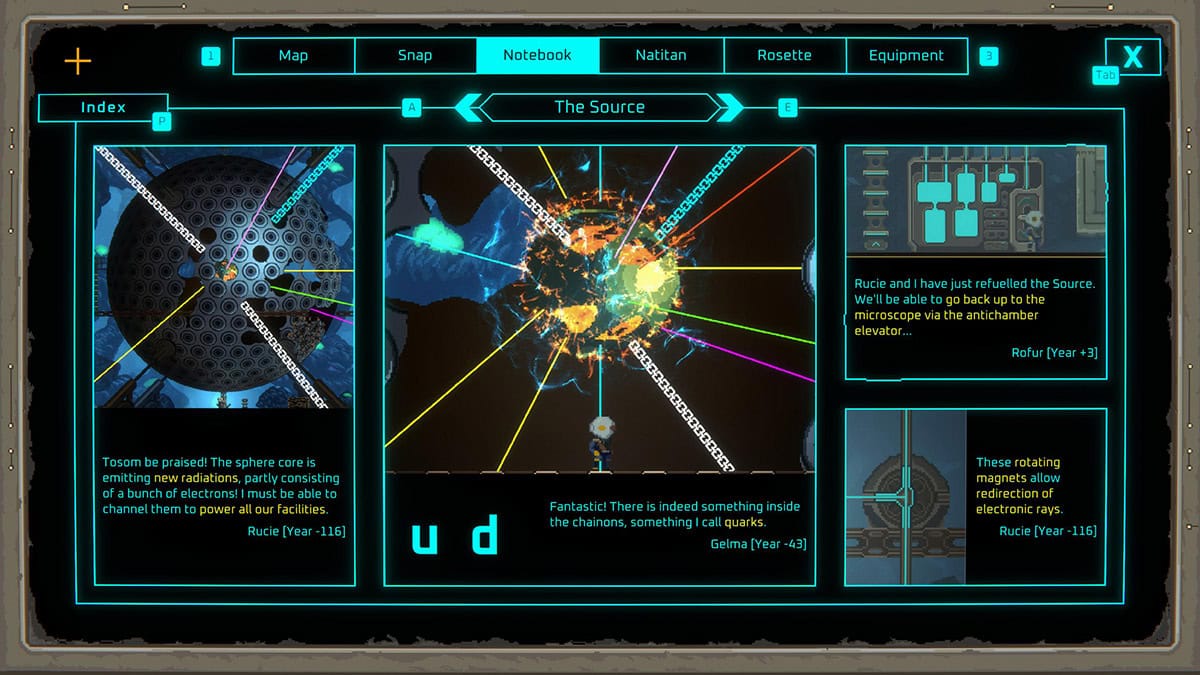Science
Explore Particle Physics with Exographer: A Unique Gaming Journey

In a landscape dominated by fast-paced video games, *Exographer* stands out as a thoughtful and immersive experience that integrates elements of particle physics with interactive storytelling. Developed by particle physicist and science-fiction author Raphaël Granier de Cassagnac and his studio SciFunGames, this puzzle-platformer invites players to navigate a decaying alien civilization while engaging with scientific concepts in a playful manner.
The narrative begins with the protagonist, Ini, an alien explorer who discovers a multifunctional camera shortly after landing on a seemingly deserted planet. This camera becomes crucial for players, enabling environmental analysis, teleportation, and the discovery of subatomic particles through puzzles inspired by Richard Feynman diagrams. Players must match particle trajectories using various analytical tools, mirroring the investigative processes of actual physicists.
Gameplay and Puzzle Mechanics
As players progress through *Exographer*, they will encounter a series of puzzles that require both dexterity and intellect. Tracking and redirecting beamlines helps players unlock deeper understandings of the particles that comprise this alien world. Each puzzle cracked opens new areas, encouraging exploration and critical thinking.
For those who may find themselves stuck, a helpful hint is to use the camera when encountering backgrounds that seem unusual. Clues are often hidden in these environments, waiting to be uncovered.
The game’s pixel-art style is not just an aesthetic choice; it symbolizes the fundamental “pixels” of the universe, representing elementary particles. As players delve deeper, they encounter various particles such as electrons, gluons, and muons, each unlocking new abilities that enhance gameplay.
Visuals and Soundtrack
The environments in *Exographer* are meticulously crafted, drawing inspiration from real-world laboratories and observatories. While I played the game on Nintendo Switch, it is also available on PS5, Xbox, and Steam, maintaining a consistent visual experience across platforms.
Accompanying the engaging gameplay is an atmospheric soundtrack composed by Yann Van Der Cruyssen, known for his work on the game *Stray*. The music enhances the sense of wonder, highlighting themes of exploration and scientific inquiry.
What distinguishes *Exographer* is its ability to educate without sacrificing entertainment. The seamless integration of scientific concepts offers players a glimpse into the world of particle physics. Nonetheless, some puzzles may present a steep learning curve, posing challenges for those less familiar with scientific reasoning.
Overall, *Exographer* is more than just a video game; it serves as an experience that bridges the gap between science and art. It invites players to think critically, explore patiently, and appreciate the intricate beauty of the universe’s building blocks.
For players willing to engage with its depth, *Exographer* promises a rewarding journey that resonates long after the console is turned off. The game is available at a price of £17.99 for Nintendo Switch, £15.99 for PS5, £16.74 for Xbox, and £16.75 for PC.
As the gaming industry continues to evolve, *Exographer* represents a notable shift towards games that challenge players intellectually while providing an enriching experience.
-

 Entertainment3 months ago
Entertainment3 months agoAnn Ming Reflects on ITV’s ‘I Fought the Law’ Drama
-

 Entertainment4 months ago
Entertainment4 months agoKate Garraway Sells £2 Million Home Amid Financial Struggles
-

 Health3 months ago
Health3 months agoKatie Price Faces New Health Concerns After Cancer Symptoms Resurface
-

 Entertainment3 months ago
Entertainment3 months agoCoronation Street’s Carl Webster Faces Trouble with New Affairs
-

 Entertainment3 months ago
Entertainment3 months agoWhere is Tinder Swindler Simon Leviev? Latest Updates Revealed
-

 Entertainment4 months ago
Entertainment4 months agoMarkiplier Addresses AI Controversy During Livestream Response
-

 World2 weeks ago
World2 weeks agoBailey Announces Heartbreaking Split from Rebecca After Reunion
-

 Science1 month ago
Science1 month agoBrian Cox Addresses Claims of Alien Probe in 3I/ATLAS Discovery
-

 Entertainment2 weeks ago
Entertainment2 weeks agoCoronation Street Fans React as Todd Faces Heartbreaking Choice
-

 Health4 months ago
Health4 months agoCarol Vorderman Reflects on Health Scare and Family Support
-

 Entertainment4 months ago
Entertainment4 months agoKim Cattrall Posts Cryptic Message After HBO’s Sequel Cancellation
-

 Entertainment3 months ago
Entertainment3 months agoOlivia Attwood Opens Up About Fallout with Former Best Friend









